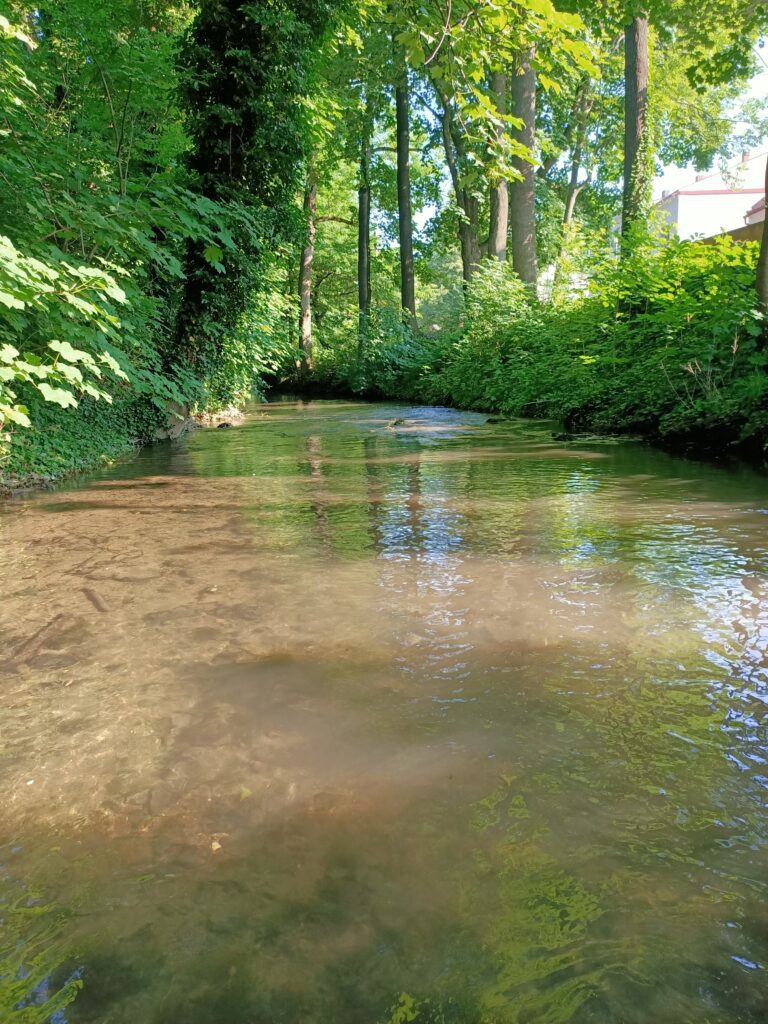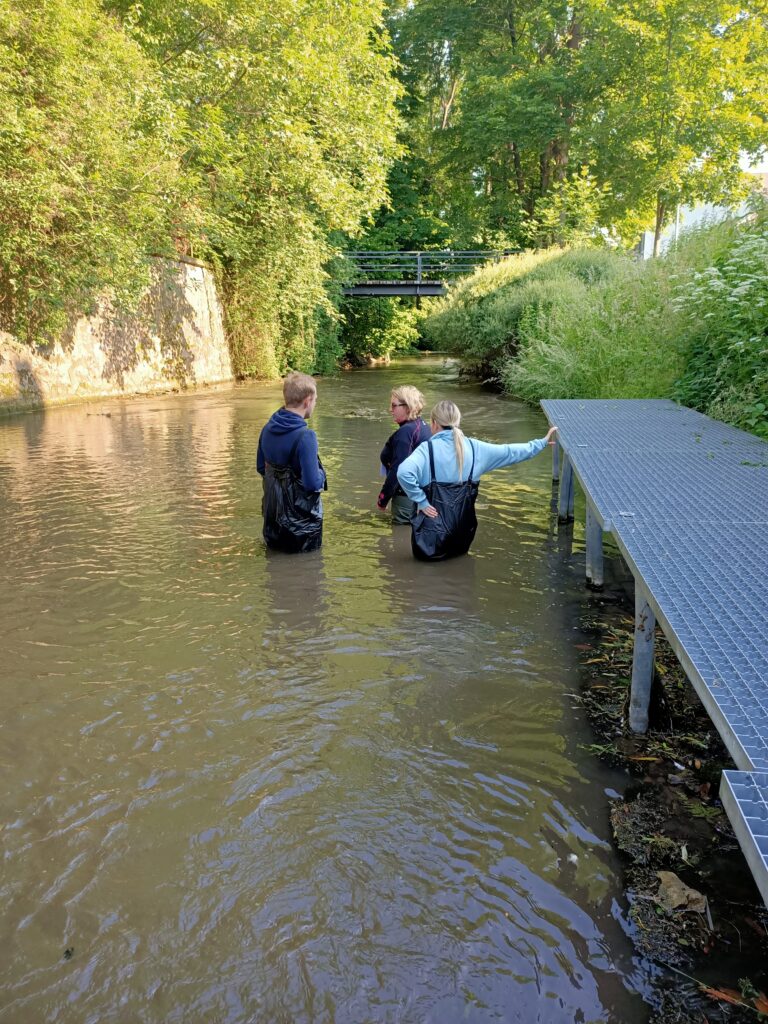It’s seven in the morning. 15. June. We sit on the still cold wall on the Water Walls and with a little embarrassment we squeeze into our fishing waders. We’re having a hard time, none of us have worn pants like that before. In a little while we will go down the Loučná river to get acquainted with the long-awaited art project. Its beginning is accompanied by the intense smell of rubber and the feeling of heavy legs. We move quite clumsily in trousers that almost reach our shoulders. When walking, we have to unnaturally lengthen our stride to be able to move in them at all, and to keep up with our two guides – artists Nikola Šrubařová and Karina Brabcová. We are participating in their latest work Biotop Loučná, which they have prepared for this year’s exhibition Plan B.
Only a few days ago, one of the works arrived in our gallery by courier. Narrow blue zine printed on recycled paper. It is full of photographs, drawings, notes and snippets of interviews. It maps the river Loučná and smells of a printer.
As we walk to the starting point of today’s walk, we all mentally reflect on the nature of Nikolina and Karina’s project. We know almost nothing about it yet. We only know about the narrow blue booklet and we know that they both visited Litomyšl several times, had conversations about the river with biologist Lubor Urbánek and Antonín Dokoupil, who is in charge of the town’s development, and walked the river in rubber pants. Today we will enter their artistic project and become part of the creative process.
We came to the raft. In rubber trousers, already a little less clumsy, we walk up the steps to Loučná near the pub Za vodou, where the painter Josef Voleský was born. What would this artist, for whom the mastery of the means of painting was above all in the work of art, have thought of us, when in the work in which we are participating today only the pen drawings in the blue book remain of the whole great chapter of painting?
We’re waist-deep in water. We can feel how cold it is. Finally, we learn the details of the Loučná Biotope project. While “mapping” it, Karina and Nikola crossed the river several times from Benátky to Lidl department store. They recorded the depth and colour of the water, the river bed, the river channel and the materials of which it is built, the relationship of the river to the settlement, observed life in the water and on the adjacent banks, took photographs and drawings of plants. Today, the artists give us their experiences from their research. She teaches us how to recognize that the river is healthy and shares with us her own feelings from her individual visits to Litomyšl. The first one, in spring, was characterized by the enthusiasm for the beautiful city and its architecture. The other is a slightly more critical view of the river itself and how little the river is part of the everyday life of the city’s inhabitants. In the blue book, this knowledge is mapped out in terms of “Recreation Deficit” or “We move in the city, and we hardly see the other city”.
We wade downstream together. We learn where what kind of birds nest, where what grows or where the muddy subsoil alternates with the rocky one. We write down our own impressions in the handmade notebooks we received from the artists. We observe how ambient sounds change. In some places we can barely hear each other, in others there is a great silence. We pass under the new overpass and the building appears even taller and more massive from our new perspective. Fortunately, it still remains within the scale of our city. Every now and then one of us steps on the soft muddy ground and staggers. We talk all the time, but the pace of the conversation is slow. We are aware that the slower pace of the conversation is set by the authors of the happening themselves. They are crossing the river for several times and they know very well that they are acting as uninvited guests. Even today they do not intend to disturb the fragile river ecosystem in any way. We’re adapting. We’re strangers here too. By quietly observing, we try to understand the surrounding nature and water. We experience very unusual, strong and pleasant feelings.
We ask women artists about the theme of ecology in their works. They describe their ongoing Feedback Project, which deals with soil erosion in Iceland. The theme of soil is ever present in their work. For the exhibition in Zlín, called Earth Beneath Our Feet, for example, they created a haptic material laboratory of Zlín’s nature. The online exhibition “Soil, Clay, Earth” again visualized the contemporary relationship between humans and soil.
Our morning walk through Loučná ends after about two hours. The river got progressively deeper, darker and colder. We get out of the water on the shore near the Penny Market in Litomyšl. Each with their own feelings and thoughts jumping over each other. In a head that is used to sorting through information and searching for answers to questions about the artistic quality of a work, it is boiling. After a few steps on land, however, everything suddenly falls into place. Nikola and Karina create artworks that are meant to cultivate our thinking, and the purpose of the visual images they create or mediate is to bring into our field of vision issues that deserve attention or that for some reason remain hidden from our attention. Their soil mapping brought public attention to the soil and drew attention to invasive land management. A similar approach was chosen by the artists here in Litomyšl. However, soil has been replaced by water, which is reduced in the popular mind to a purely utilitarian thing. We don’t care much about its protection or its future. Through an unusual experience in the form of a walk on water, both artists drew our attention to this topic in a playful yet very intense way. After flipping through the blue zine and taking today’s walk, we cherish a sense of beauty and joy that is similar to the feelings we experience when looking at some of the great works of art in a gallery, for example. Today, however, water and nature have replaced the means of art. Their constancy, fragility and liveliness.


